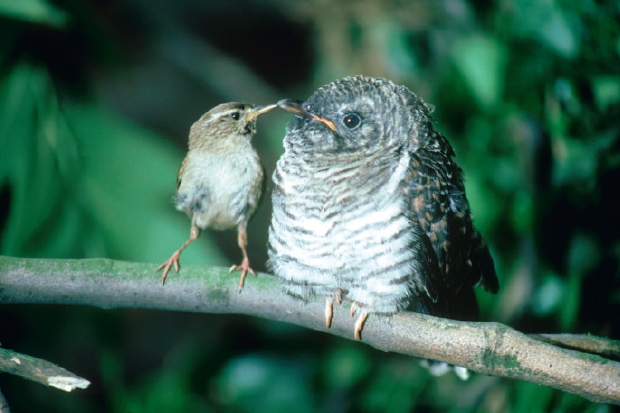In recent years there has been a fashion for so-called ‘new nature writing’, where the works are invariably heavy with emotion, while the descriptions of place and wildlife often serve as a hazy green backcloth against which the author depicts the main subject —their own personalities.
It comes as something of a shock, therefore, to find a new nature book that returns to a traditional format. It’s one in which the character of the writer barely intrudes and the real subject, picked apart in meticulous detail, is nature itself. In the hands of a scholar who is also a first-rate storyteller, you realise just how entertaining such a work can be. Nick Davies’s Cuckoo is a model of that genre — part gripping detective story, part evocation of place and season, but also a glorious reminder of the sheer wonder of our planet and all its strange life forms.
Yet it is hard to imagine a more fascinating theme. The cuckoo’s cultural place in Britain is loaded with superlatives. It’s the source of the oldest song in the language (‘Sumer is icumen in’) and, aside from the lark and nightingale, it has also given rise to the greatest body of folklore, myth and literary reference of any bird. However, what makes the creature such a tailor-made topic for the behavioural ecologist is the weirdness of its reproductive strategy, which Gilbert White called ‘a monstrous outrage on maternal affection’.
Based at Wicken Fen, the National Trust reserve in Cambridgeshire, Davies has unravelled some of the key mysteries of this secretive creature. It was not until the 1920s that ornithologists even knew how female cuckoos got their eggs into the nests of their unsuspecting hosts. Two false theories had sufficed for decades: that they either laid them on the ground and then regurgitated them or popped them in with their beaks.
It was a Midlands businessman, Edgar Chance, who finally caught the act on film after years of extraordinarily diligent fieldwork. Turns out that the bird lays it in the traditional way, but so quickly that no one had realised what was happening. The prospective mother can swoop down, land on the nest, squirt out an egg, take one of the host’s eggs and fly off in just four seconds.
Not only does Davies unravel all this background history to cuckoo studies, but it is his personal field work that has identified why there is such need for speed. One set of his experiments at Wicken Fen involved placing stuffed cuckoos in the breeding territories of reed warblers, which is one of the species that is regularly parasitised. The author had already seeded the warblers’ own nest with an artificial cuckoo egg. In 40 per cent of the tests the reed warblers responded to the model bird by rejecting the false egg. At nests where no model cuckoo was displayed the rejections occurred in only 3 per cent of cases.
The fact that many would-be foster parents are wise to the cheating ways of cuckoos has led to what Davies calls an ‘evolutionary arms race’. The hosts and brood parasite develop ever more effective strategies to outwit each other. One consequence of this million-year-old contest is that cuckoos have eggs that are often remarkably similar to their habitual hosts.
A countermeasure by a whole range of birds is to produce eggs with complex squiggles and patterns on them that serve as signatures to identify their own true progeny. Davies discovered that several common British birds, including the reed bunting, willow warbler, blackcap and chaffinch, are strong rejecters of eggs that are not exactly like their own. The author speculates that these reflex rejection behaviours signify how these birds have won their ‘arms race’ with the cheat. The cuckoos that once targeted them have gone extinct or moved on to easier prey like the poor old reed warbler at Wicken Fen, where one in six nests hosts a fraudulent chick that is eight times heavier than its foster parents.
One of the virtues of the book is the way that Davies has time not only for the old cuckoo folklore, but also explores the bird’s more modern symbolism. The story of cuckoos in Britain, where they have declined by 65 per cent and are seldom heard now in vast areas of the country, exemplifies a wider pattern of environmental deterioration. The author reminds us that one in eight of all the world’s 10,000 bird species is now threatened with extinction.
To secure them would cost humanity about $78 billion annually. It sounds a lot, but it is just a fifth of the money we now spend on fizzy drinks. If we were less concerned with tooth rot and more devoted to life on Earth this would surely be a better place. Certainly it seems more extraordinary and filled with wonder after reading Davies’s outstanding book.
Available from the Spectator Bookshop, £13.99 Tel: 08430 600033. Mark Cocker is a naturalist and author of Crow Country, Birds and People and Birds Britannica (with Richard Mabey).






Comments